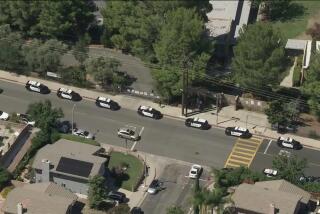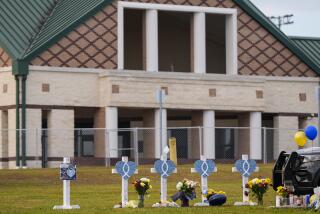Help for Helpers of Traumatized Students
- Share via
WASHINGTON — Two years ago in Butte, Mont., a fourth-grader fatally shot another student in the back of the head with a .22-caliber pistol.
Margaret Leary Elementary School Principal Kate Stetzner grabbed the phone, called 911 and began shouting, “Get a nurse! Get the kids away! Get the kids away! Get the kids away!”
Still on the phone with the 911 operator, the principal turned to the student who fired the fatal shot to ask, “Where is the gun, honey? Did you bring the gun to school? Where did you find the gun, sweetheart?”
Crises like the one that occurred on the school playground and the trauma experienced by students are played out at American schools every year.
Crisis counselors, mental health workers, principals and others are dealing with rising numbers of homicides, stabbings and suicides as well as natural disasters, such as floods, earthquakes and the Oklahoma City bombing in April 1995.
Two dozen of these professionals met in Washington this month with officials from the departments of Education, Justice, and Health and Human Services to discuss how their agencies can help school officials respond to disasters.
The difficulties sometimes are not short-lived:
* Discipline problems doubled at Stetzner’s school in Montana after the April 1994 shooting. A year later, the same schoolchildren experienced problems when a man killed a woman in front of a nearby school, she said.
* After Rodney King was beaten by police officers after a car chase in 1991, schoolchildren in Los Angeles acted out the beating on playgrounds, said Marleen Wong, mental health director for the Los Angeles Unified School District.
“The younger the child, the more they would play it out,” Wong said. “Children act out what they fear. They don’t talk about it like adults usually do.”
* Schoolchildren affected by the federal building bombing in Oklahoma City initially experienced fear, but now are expressing anger as the trial of a bombing suspect gets underway, said Annette Murphy, the Federal Emergency Management Agency grant coordinator in the city.
“I think they’re doing well, but a lot are still not through the recovery process, and because the trial issues keep coming up, they can’t get closure,” Murphy said.
“First, it was fear. Now, we have a lot of anger coming out. A lot of kids really want to get [bombing suspect Timothy] McVeigh,” she said, punching her fist into her palm.
Sixty child psychologists and members of crisis-intervention teams from across the nation traveled to Oklahoma City to counsel schoolchildren and staff after the bombing, Murphy said. They were there four days.
After they left, the 70 to 80 regular school counselors were left to calm and counsel the 41,000 students in the Oklahoma City Public Schools.
Sixty-nine of the district’s 88 schools reported having students or staff members who lost relatives in the bombing. About 500 to 600 of the students knew someone killed or injured in the bombing. Several thousand others were indirectly affected, Murphy said.
Although each situation is different, children who witness shootings or live through an earthquake or flood all suffer some similar symptoms, Wong said.
They experience fear, sleepless nights, eating disorders and trouble concentrating or coping with daily activities.
Some children act out; others have lifeless responses, becoming almost robot-like, she said.
“Children can be victims of traumatic stress just like Vietnam vets,” Wong said. “They have changes in the way they feel. They say, ‘I feel crazy.’ ”
The two-day meeting in Washington was designed to provide a well-coordinated response to future disasters and find ways that the federal government can help schools cope with natural disasters and violence without duplicating services.
More to Read
Sign up for Essential California
The most important California stories and recommendations in your inbox every morning.
You may occasionally receive promotional content from the Los Angeles Times.










